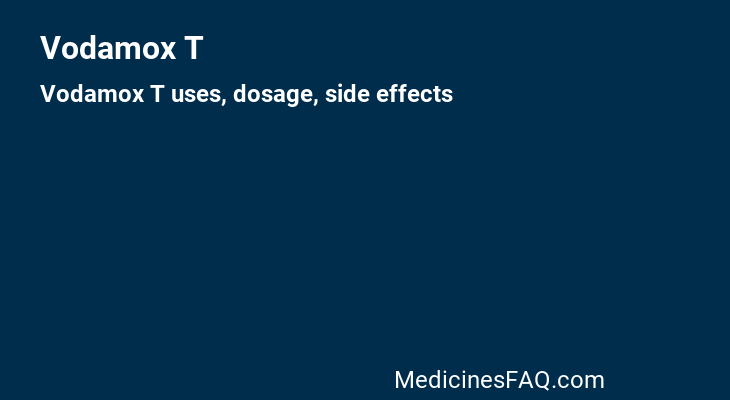Vodamox T
Vodamox T Uses, Dosage, Side Effects, Food Interaction and all others data.
Moxifloxacin is a synthetic broad spectrum, flouroquinolone derivative antibacterial agent. Moxifloxacin has in vitro activity against a wide range of Gram-positive and Gram-negative microorganisms. The bactericidal action of Moxifloxacin results from inhibition of the topoisomerase II (DNA gyrase) and topoisomerase IV required for bacterial DNA replication, transcription, repair and recombination.
Moxifloxacin is a quinolone/fluoroquinolone antibiotic. Moxifloxacin can be used to treat infections caused by the following bacteria: Aerobic Gram-positive microorganisms: Corynebacterium species, Micrococcus luteus, Staphylococcus aureus, Staphylococcus epidermidis, Staphylococcus haemolyticus, Staphylococcus hominis, Staphylococcus warneri, Streptococcus pneumoniae, and Streptococcus viridans group. Aerobic Gram-negative microorganisms: Acinetobacter lwoffii, Haemophilus influenzae, and Haemophilus parainfluenzae. Other microorganisms: Chlamydia trachomatis.Moxifloxacin is bactericidal and its mode of action depends on blocking of bacterial DNA replication by binding itself to an enzyme called DNA gyrase, which allows the untwisting required to replicate one DNA double helix into two. Notably the drug has 100 times higher affinity for bacterial DNA gyrase than for mammalian. Moxifloxacin is a broad-spectrum antibiotic that is active against both Gram-positive and Gram-negative bacteria.
Tobramycin interferes with bacterial protein synthesis by binding to 30S and 50S ribosomal subunits, resulting in a defective bacterial cell membrane.
Tobramycin is an aminoglycoside antibiotic derived from the actinomycete Streptomyces tenebrarius. It has a broad spectrum of activity against Gram-negative bacteria, including Enterobacteriaceae, Escherichia coli, Klebsiella pneumoniae, Morganella morganii, Moraxella lacunata, Proteus spp., Haemophilus spp., Acinetobacter spp., Neisseria spp., and, importantly, Pseudomonas aeruginosa. Aminoglycosides also generally retain activity against the biothreat agents Yersinia pestis and Francisella tularensis. In addition, aminoglycosides are active against some Gram-positive bacteria such as Staphylococcus spp., including methicillin-resistant (MRSA) and vancomycin-resistant strains, Streptococcus spp., and Mycobacterium spp.
Like other aminoglycosides, tobramycin is taken up and retained by proximal tubule and cochlear cells in the kidney and ear, respectively, and hence carries a risk of nephrotoxicity and ototoxicity. There is also a risk of neuromuscular block, which may be more pronounced in patients with preexisting neuromuscular disorders such as myasthenia gravis or Parkinson's disease. Aminoglycosides can cross the placenta, resulting in total, irreversible, bilateral congenital deafness in babies born to mothers who were administered an aminoglycoside during pregnancy. Due to the low systemic absorption of inhaled and topical tobramycin formulations, these effects are more pronounced with injected tobramycin than with other formulations. However, all formulations carry a risk of hypersensitivity reactions, including potentially fatal cutaneous reactions such as Stevens-Johnson syndrome and toxic epidermal necrolysis.
| Trade Name | Vodamox T |
| Generic | Moxifloxacin + Tobramycin |
| Weight | 0.5% |
| Type | Eye Drops |
| Therapeutic Class | |
| Manufacturer | Calix Life Sciences Pvt Ltd |
| Available Country | India |
| Last Updated: | September 19, 2023 at 7:00 am |

Uses
Moxifloxacin is used for the treatment of adults (>18 years of age) with infections caused by susceptible strains of the designated microorganisms in the conditions listed below-
- Acute Bacterial Sinusitis caused by Streptococcus pneumoniae, Haemophilus infuenzae or Moraxella catarrhalis.
- Acute Bacterial Exacerbation of Chronic Bronchitis caused by Streptococcus pneumoniae, Haemophilus infuenzae, Haemophilus parainfuenzae, Klebsiella pneumoniae, methicillin-susceptible Staphylococcus aureus or Moraxella catarrhalis
- Community Acquired Pneumonia caused by Streptococcus pneumoniae (including multi-drug resistant strains), Haemophilus infuenzae, Moraxella catarrhalis, methicillin-susceptible Staphylococcus aureus, Klebsiella pneumoniae, Mycoplasma pneumoniae or Chlamydophilia pneumoniae.
- Uncomplicated Skin and Skin Structure Infections caused by methicillin-susceptible Staphylococcus aureus or Streptococcus pyogen.
- Complicated Skin and Skin Structure Infections caused by methicillin-susceptible Staphylococcus aureus, Escherichia coli, Klebsiella pneumoniae or Enterobacter cloacae.
- Complicated Intra-Abdominal Infections including polymicrobial infections such as abscess caused by Escherichia coli, Bacteroides fragilis, Streptococcus anginosus, Streptococcus constellatus, Enterococcus faecalis, Proteus mirabilis, Clostridium perfringens, Bacteroides thetaiotaomicron or Peptostreptococcus species.
Tobramycin Respirator Solution is used for the management of cystic fibrosis patients with Pseudomonas aeruginosa. Also used for severe COPD patients colonized with Pseudomonas aeruginosa. Safety and efficacy have not been demonstrated in patients below the age of 6 years, patients with a forced expiratory volume <25% or >75% predicted, or patients colonized with Burkholderia cepacia.
For the treatment of external infections of the eye and its adnexa caused by susceptible bacteria. Appropriate monitoring of bacterial response to topical antibiotic therapy should accompany its use.
Vodamox T is also used to associated treatment for these conditions: Acute Exacerbation of Chronic Bronchitis (AECB), Bacterial Conjunctivitis, Community Acquired Pneumonia (CAP), Plague, Postoperative Inflammatory Response, Sinusitis, Skin Infections, Ocular bacterial infections, Post-operative infectionBacterial Peritonitis, Bone Infection, Cystic fibrosis, Pseudomonas aeruginosa infection, Eye Infections, Inflammation of the External Auditory Canal, Intra-Abdominal Infections, Lower respiratory tract infection bacterial, Meningitis, Bacterial, Ocular Inflammation, Septicemia gram-negative, Skin and Subcutaneous Tissue Bacterial Infections, Corticosteroid-responsive Disorder of the Ophthalmic, Ear infection-not otherwise specified caused by susceptible bacteria, Ocular bacterial infections, Recurrent Complicated Urinary Tract Infection, Steroid-responsive inflammation
How Vodamox T works
The bactericidal action of moxifloxacin results from inhibition of the enzymes topoisomerase II (DNA gyrase) and topoisomerase IV. DNA gyrase is an essential enzyme that is involved in the replication, transcription and repair of bacterial DNA. Topoisomerase IV is an enzyme known to play a key role in the partitioning of the chromosomal DNA during bacterial cell division.
Tobramycin is a 4,6-disubstituted 2-deoxystreptamine (DOS) ring-containing aminoglycoside antibiotic with activity against various Gram-negative and some Gram-positive bacteria. The mechanism of action of tobramycin has not been unambiguously elucidated, and some insights into its mechanism rely on results using similar aminoglycosides. In general, like other aminoglycosides, tobramycin is bactericidal and exhibits both immediate and delayed killing, which are attributed to different mechanisms, as outlined below.
Aminoglycosides are polycationic at physiological pH, such that they readily bind to bacterial membranes ("ionic binding"); this includes binding to lipopolysaccharide and phospholipids within the outer membrane of Gram-negative bacteria and to teichoic acid and phospholipids within the cell membrane of Gram-positive bacteria. This binding displaces divalent cations and increases membrane permeability, which allows aminoglycoside entry. Additional aminoglycoside entry ("energy-dependent phase I") into the cytoplasm requires the proton-motive force, allowing access of the aminoglycoside to its primary intracellular target of the bacterial 30S ribosome. Mistranslated proteins produced as a result of aminoglycoside binding to the ribosome (see below) integrate into and disrupt the cell membrane, which allows more of the aminoglycoside into the cell ("energy-dependent phase II"). Hence, tobramycin and other aminoglycosides have both immediate bactericidal effects through membrane disruption and delayed bactericidal effects through impaired protein synthesis; observed experimental data and mathematical modelling support this two-mechanism model.
Inhibition of protein synthesis was the first recognized effect of aminoglycoside antibiotics. Structural and cell biological studies suggest that aminoglycosides bind to the 16S rRNA in helix 44 (h44), near the A site of the 30S ribosomal subunit, altering interactions between h44 and h45. This binding also displaces two important residues, A1492 and A1493, from h44, mimicking normal conformational changes that occur with successful codon-anticodon pairing in the A site. Overall, aminoglycoside binding has several negative effects, including inhibiting translation initiation and elongation and ribosome recycling. Recent evidence suggests that the latter effect is due to a cryptic second binding site situated in h69 of the 23S rRNA of the 50S ribosomal subunit. Also, by stabilizing a conformation that mimics correct codon-anticodon pairing, aminoglycosides promote error-prone translation; mistranslated proteins can incorporate into the cell membrane, inducing the damage discussed above.
Although direct mutation of the 16S rRNA is a rare resistance mechanism, due to the gene being present in numerous copies, posttranscriptional 16S rRNA modification by 16S rRNA methyltransferases (16S-RMTases) at the N7 position of G1405 or the N1 position of A1408 are common resistance mechanisms in aminoglycoside-resistant bacteria. These mutants also further support the proposed mechanism of action of aminoglycosides. Direct modification of the aminoglycoside itself through acetylation, adenylation, and phosphorylation by aminoglycoside-modifying enzymes (AMEs) are also commonly encountered resistance mutations. Finally, due to the requirement for active transport of aminoglycosides across bacterial membranes, they are not active against obligately anaerobic bacteria.
Dosage
Vodamox T dosage
The dose of Moxifloxacin is 400 mg once every 24 hours. The duration of therapy depends on the type of infection as described bellow-
- In Acute Bacterial Sinusitis: Moxifloxacin 400 mg is given once daily for 10 days.
- In Acute Bacterial Exacerbation of Chronic Bronchitis: Moxifloxacin 400 mg is given once daily for 5 days.
- In Community Acquired Pneumonia: Moxifloxacin 400 mg is given once daily for 7-14 days.
- In Uncomplicated Skin & Skin Structure infections: Moxifloxacin 400 mg is given once daily for 7 days.
- In Complicated Skin & Skin Structure infections: Moxifloxacin 400 mg is given once daily for 7-21 days.
- In Complicated Intra-Abdominal infections: Moxifloxacin 400 mg is given once daily for 5-14 days.
Moxifloxacin 400 mg IV infusion can be administered intravenously for the entire treatment duration. Alternatively, therapy may be initial intravenous administration, followed by oral administration when clinically indicated. The recommended duration of treatment for the indication being treated should not be exceeded. The solution for infusion should be infused intravenously over 60 minutes.
Tobramycin (Respirator Solution) The recommended dosage for, both adult and paediatric patients, 6 years of age and older, is one single-use ampoule (300 mg) administered b.i.d for 28 days. Dosage is not adjusted by weight.
The doses should be taken as close to 12 hours apart as possible; they should not be taken less than 6 hours apart.
If you are taking several medications, the recommended order is as follows: bronchodilator first, followed by chest physiotherapy, then other inhaled medications and finally Tobramycin.
You should take Tobramycin in repeated cycles of 28 days on drug, followed by 28 days off drug. You should take Tobramycin twice a day during the 28 day period on drug.
Tobramycin Eye Drops: In mild to moderate disease, 1 drop into the affected eye(s) every 4 hours. In severe infections, 1 drop into the affected eye(s) hourly until improvement, following which dosage should be reduced prior to discontinuation.
Tobramycin Eye Ointment: In mild to moderate disease it should be applied thinly and evenly into the conjunctival sac of the affected eyes 2 to 3 times per day. For severe cases it should be applied thinly and evenly into the conjunctival sac of the affected eyes 3 to 4 times per day. Following improvement, treatment should be reduced prior to discontinuation.
Side Effects
The following one or more side effects may be observed: tendinopathy and tendon rupture, QT prolongation, hypersensitivity reactions, Clostridium difficile-associated diarrhea, peripheral neuropathy, photosensitivity, phototoxicity etc.
Inhaled Tobramycin is generally well-tolerated. Voice alterations and tinnitus are more common in the on-drug periods. However all the episodes are transient and resolved without discontinuation of the regimen. Others like dizziness and increase in serum creatinine were similar to those occurring with placebo.
The most frequent adverse reactions to Tobramycin are localized ocular toxicity and hypersensitivity, including lid itching and swelling and conjunctival erythema. These reactions occur in less than 3% of patients treated.
Toxicity
Symptoms of overdose include CNS and gastrointestinal effects such as decreased activity, somnolence, tremor, convulsions, vomiting, and diarrhea. The minimal lethal intravenous dose in mice and rats is 100 mg/kg.
Toxicity information regarding tobramycin is not readily available. Patients experiencing an overdose are at an increased risk of severe adverse effects such as nephrotoxicity, ototoxicity, neuromuscular blockade, and respiratory failure/paralysis. Symptomatic and supportive measures are recommended; hemodialysis may help clear excess tobramycin. Accidental ingestion of tobramycin is unlikely to result in an overdose, as aminoglycosides are poorly absorbed in the gastrointestinal tract.
Poor gastrointestinal absorption is reflected in animal studies. When administered by the intraperitoneal or subcutaneous route, the LD50 for mice and rats ranges from 367-1030 mg/kg while the oral LD50 values are more than 7500 mg/kg.
Precaution
Moxifloxacin should be discontinued at the first appearance of a skin rash or any other sign of hypersensitivity. Moxifloxacin should be discontinued if the patient experiences pain, swelling, inflammation or rupture of a tendon.
As with other anti-infective, prolonged use may result in overgrowth of non-susceptible organisms, including fungi. If super-infection occurs, discontinue use and institute alternative therapy. Patients should be advised not to wear contact lenses if they have signs and symptoms of bacterial conjunctivitis.
Warning: Do not touch the dropper or tube opening to any surface, including eyes or hands. The dropper or tube opening is sterile. If it becomes contaminated, it could cause an infection in the eye. Use caution when driving, operating machinery, or performing other hazardous activities. Tobramycin ophthalmic may cause blurred vision. If blurred vision is experienced, avoid these activities. Caution should be taken to wear the contact lenses. After applying the medication, wait at least 15 minutes before inserting contact lenses, unless otherwise directed by doctor. Do not use other eye drops or medications during treatment with tobramycin ophthalmic unless otherwise directed by doctor
Interaction
No quinolone should be co-administered with any solution containing multivalent cations (e.g. magnesium) through the same intravenous line. Antacids, iron and adsorbents reduce absorption of Moxifloxacin. NSAID may increase the risk of CNS stimulation. Warfarin may increase the risk of bleeding.
Patients taking Tobramycin concomitantly with beta agonists, inhaled corticosteroids, other anti pseudomonal antibiotics or parenteral aminoglycosides demonstrated adverse experience profiles.
Specific drug interaction studies on Tobramycin ophthalmic preparation have not been established
Volume of Distribution
- 1.7 to 2.7 L/kg
Inhalation tobramycin had an apparent volume of distribution in the central compartment of 85.1 L for a typical cystic fibrosis patient.
Elimination Route
Well absorbed from the gastrointestinal tract. Absolute oral bioavailability is approximately 90%. Food has little effect on absorption.
Tobramycin administered by inhalation in cystic fibrosis patients showed greater variability in sputum as compared to serum. After a single 112 mg dose, the serum Cmax was 1.02 ± 0.53 μg/mL, which was reached in one hour (Tmax), while the sputum Cmax was 1048 ± 1080 μg/g. Comparatively, for a 300 mg dose, the serum Cmax was 1.04 ± 0.58 μg/mL, which was also reached within one hour, while the sputum Cmax was 737 ± 1028 μg/g. The systemic exposure (AUC0-12) was also similar between the two doses, at 4.6 ± 2.0 μg∙h/mL for the 112 mg dose and 4.8 ± 2.5 μg∙h/mL for the 300 mg dose. When tobramycin was administered over a four-week cycle at 112 mg twice daily, the Cmax measured one hour after dosing ranged from 1.48 ± 0.69 μg/mL to 1.99 ± 0.59 μg/mL.
Half Life
11.5-15.6 hours (single dose, oral)
Tobramycin has an apparent serum terminal half-life of ~3 hours following a single 112 mg inhaled dose in cystic fibrosis patients.
Clearance
- 12 +/- 2 L/hr
Inhaled tobramycin has an apparent serum clearance of 14.5 L/h in cystic fibrosis patients aged 6-58 years.
Elimination Route
Approximately 45% of an oral or intravenous dose of moxifloxacin is excreted as unchanged drug (~20% in urine and ~25% in feces).
Tobramycin is primarily excreted unchanged in the urine.
Pregnancy & Breastfeeding use
Pregnancy Category C. Moxifloxacin is not recommended during pregnancy & lactation.
Pregnancy: This drug should be used during pregnancy only if clearly needed.
Lactation: Because of the potential for adverse reactions in nursing infants from Tobramycin, a decision should be made whether to discontinue nursing the infant or discontinue the drug, taking into account the importance of the drug to the mother.
Contraindication
Moxifloxacin is contraindicated in persons with a history of hypersensitivity to Moxifloxacin or any member of the quinolone class of antimicrobial agents and any component of this formulation.
In patients with known hypersensitivity to any component of the product. Partial crossallergenicity to other aminoglycosides has been established.
Special Warning
Elderly: No adjustment of dosage is required in the elderly.
Children: Efficacy and safety of Moxifloxacin IV infusion in children and adolescent have not been established.
Renal Impairment: Inhalation: Dosage adjustment needed.
Acute Overdose
In the events of an acute overdose, the stomach should be emptied. The patient should be kept under observation and appropriate hydration should be maintained.
Symptoms: Nephrotoxicity, auditory and vestibular toxicity (e.g. dizziness, tinnitus, vertigo, loss of high-tone hearing acuity), neuromuscular blockade or resp failure.
Management: Initiate resuscitative measures if resp paralysis occurs. Ca salts may be given to reverse neuromuscular blockade. Haemodialysis or peritoneal dialysis will help remove drug serum levels.
Storage Condition
Store between 15 to 30° C. Protect from light and moisture. Keep away from reach of children.
Store under refrigeration at 2-8° C, and protected from light. Slight color change when unrefrigerated do not indicate any change in the quality of the product. The preparation must not be used if it is cloudy, particles appear in the solution or has been stored at room temperature for over 28 dyas. For use only under the prescription of a registered physician. Do not use beyond the expiration date stamped on the ampoule.
Eye Drops Store in a cool and dry place, away from light. Keep out of reach of children.
Innovators Monograph
You find simplified version here Vodamox T







